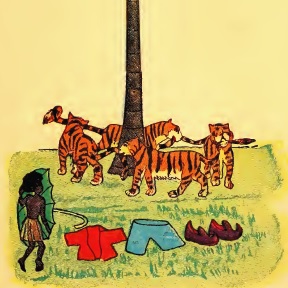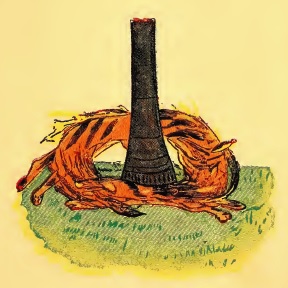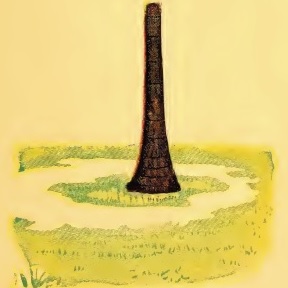And the Tigers were very, very angry, but still they would not let go of each others’ tails. And they were so angry, that they ran round the tree, trying to eat each other up, and they ran faster and faster, till they were whirling round so fast that you couldn’t see their legs at all.
And they still ran faster and faster and faster, till they all just melted away, and there was nothing left but a great big pool of melted butter (or “ghi,” as it is called in India) round the foot of the tree.



The Story of Little Black Sambo
by Helen Bannerman
Open Library
https://openlibrary.org/books/OL6659739M/The_story_of_Little_Black_Sambo
PREFACE.
There is very little to say about the story of Little Black Sambo. Once upon a time there was an English lady in India, where black children abound and tigers are everyday affairs, who had two little girls, To amuse these little girls she used now and then to invent stories, for which, being extremely talented, she also drew and coloured the pictures. Among these stories Little Black Sambo, which was made up on a long railway journey, was the favourite ; and it has been put into a Dumpy Book, and the pictures copied as exactly as possible, in the hope that you will like it as much as the two little girls did.
The Story of Little Black Sambo.
ONCE upon a time there was a little black boy, and his name was Little Black Sambo.
And his Mother was called Black Mumboo.
And his Father was called Black Jumbo.
And Black Mumbo made him a beautiful little Red Coat, and a pair of beautiful little Blue Trousers,
And Black Jumbo went to the Bazaar, and bought him a beautiful Green Umbrella, and a lovely little Pair of Purple Shoes with Crimson Soles and Crimson Linings.
And then wasn’t Little Black Sambo grand ?
So he put on all his Fine Clothes, and went out for a walk in the Jungle. And by and by he met a Tiger. And the Tiger said to him, “Little Black Sambo, I’m going to eat you up!” And Little Black Sambo said, “Oh! Please Mr. Tiger, don’t eat me up, and I’ll give you my beautiful little Red Coat.” So the Tiger said, “Very well, I won’t eat you this time, but you must give me your beautiful little Red Coat.” So the Tiger got poor Little Black Sambo’s beautiful little Red Coat, and went away saying, “Now I’m the grandest Tiger in the Jungle.”
And Little Black Sambo went on, and by and by he met another Tiger, and it said to him, “Little Black Sambo, I’m going to eat you up!” And Little Black Sambo said, “Oh! Please Mr, Tiger, don’t eat me up, and I’ll give you my beautiful little Blue Trousers.” So the Tiger said, “Very well, I wont’ eat you this time, but you must give me your beautiful little Blue Trousers.” So the Tiger got poor Little Black Sambo’s beautiful little Blue Trousers, and went away saying, “Now I‘m the grandest Tiger in the Jungle.”
And Little Black Sambo went on and by and by he met another Tiger, and it said to him, “Little Black Sambo, I’m going to eat you up!” And Little Black Sambo said, “Oh! Please Mr. Tiger, don’t eat me up, and I’ll give you my beautiful little Purple Shoes with Crimson Soles and Crimson Linings.”
But the Tiger said, “What use would your shoes be to me? I’ve got four feet, and youve got only two; you haven’t got enough shoes for me.”
But Little Black Sambo said, “You could wear them on your ears.”
“So I could,” said the Tiger: “that’s a very good idea. Give them to me, and I won’t eat you this time.”
So the Tiger got poor Little Black Sambo’s beautiful little Purple Shoes with Crimson Soles and Crimson Linings, and went away saying, “Now I‘m the grandest Tiger in the Jungle.”
And by and by Little Black Sambo met another Tiger, and it said
to him, “Little Black Sambo, I’m going to eat you up!” And Little Black Sambo said, “Oh! Please Mr. Tiger, don’t eat me up, and I’ll give you my beautiful Green Umbrella.” But the Tiger said, “How can I carry an umbrella, when I need all my paws for walking with?”
“You could tie a knot on your tail and carry it that way,” said Little Black Sambo. “So I could,” said the Tiger. “Give it to me, and I won’t eat you this time.” So he got poor little Black Sambo’s beautiful Green Umbrella, and went away saying, “Now I‘m the grandest Tiger in the Jungle.”
And poor Little Black Sambo went away crying, because the cruel Tigers had taken all his fine clothes.
Presently he heard a horrible noise that sounded like “Gr-r-r-r-rrrrrrr,” and it got louder and louder. “Oh! dear!” said Little Black Sambo, “there are all the Tigers coming back to eat me up! What shall I do?” So he ran quickly to a palm-tree, and peeped round it to see what the matter was.
And there he saw all the Tigers fighting, and disputing which of them was the grandest. And at last they all got so angry that they jumped up and took off all the fine clothes, and began to tear each other with their claws, and bite each other with their great big white teeth.
And they came, rolling and tumbling right to the foot of the very tree where Little Black Sambo was hiding, but he jumped quickly in behind the umbrella. And the Tigers all caught hold of each others’ tails, as they wrangled and scrambled, and so they found themselves in a ring round the tree.
Then, when the Tigers were very wee and very far away, Little Black Sambo jumped up, and called out, “Oh! Tigers! why have you taken off all your nice clothes? Don’t you want them any more?” But the Tigers only answered, “Gr-r-rrrrr !”
Then Little Black Sambo said, “If you want them, say so, or I’ll take them away.” But the Tigers would not let go of each others’ tails, and so they could only say “Gr-r-r-r-rrrrrrr!”
So Little Black Sambo put on all his fine clothes again and walked off.
And the Tigers were very, very angry, but still they would not let go of each others’ tails. And they were so angry, that they ran round the tree, trying to eat each other up, and they ran faster and faster, till they were whirling round so fast that you couldn’t see their legs at all.
And they still ran faster and faster and faster, till they all just melted away, and there was nothing left but a great big pool of melted butter (or “ghi,” as it is called in India) round the foot of the tree.
Now Black Jumbo was just coming home from his work, with a great big brass pot in his arms, and when he saw what was left of all the Tigers he said, “Oh! what lovely melted butter! I’ll take that home to Black Mumbo for her to cook with.”
So he put it all into the great big brass pot, and took it home to Black Mumbo to cook with.
When Black Mumbo saw the melted butter, wasn’t she pleased! “Now,” said she, “we’ll all have pancakes for supper!”
So she got flour and eggs and milk and sugar and butter, and she made a huge big plate of most lovely pancakes. And she fried them in the melted butter which the Tigers had made, and they were just as yellow and brown as little Tigers.
And then they all sat down to supper. And Black Mumbo ate Twenty-seven pancakes, and Black Jumbo ate Fifty-five, but Little Black Sambo ate a Hundred and Sixty-nine, because he was so hungry.
The Story of Little Black Sambo
Wikipedia
https://en.wikipedia.org/wiki/The_Story_of_Little_Black_Sambo
The book has a controversial history. The original illustrations by Bannerman showed a caricatured Southern Indian or Tamil child. The story may have contributed to the use of the word “sambo” as a racial slur. The book’s success led to many pirated, inexpensive, widely available versions that incorporated popular stereotypes of “black” peoples. For example, in 1908 John R. Neill, best known for his illustration of the Oz books by L. Frank Baum, illustrated an edition of Bannerman’s story. In 1932 Langston Hughes criticised Little Black Sambo as a typical “pickaninny” storybook which was hurtful to black children, and gradually the book disappeared from lists of recommended stories for children.
In 1942, Saalfield Publishing Company released a version of Little Black Sambo illustrated by Ethel Hays. During the mid-20th century, however, some American editions of the story, including a 1950 audio version on Peter Pan Records, changed the title to the racially neutral Little Brave Sambo.
The book is beloved in Japan and is not considered controversial there, but it was subject to piracy. Little Black Sambo (ちびくろサンボ Chibikuro Sanbo) was first published in Japan by Iwanami Shoten Publishing in 1953. The book was a pirated version of the original, and it contained drawings by Frank Dobias that had appeared in a US edition published by Macmillan Publishers in 1927. Sambo was illustrated as an African boy rather than as an Indian boy. Although it did not contain Bannerman’s original illustrations, the pirated book was long mistaken for the original version in Japan. It sold over 1,000,000 copies before it was pulled off the shelves in 1988 after copyright issues were raised. When the copyright expired, Kodansha and Shogakukan, the two largest publishers in Japan, published official editions. These are still in print.
As of August 2011, an equally uncontroversial “side story” for Little Black Sambo, called Ufu and Mufu, is being sold and merchandised in Japan.
ちびくろサンボ
ウィキペディア
https://ja.wikipedia.org/wiki/ちびくろサンボ
手作りの本として誕生した『ちびくろサンボ』は、知人を通してイギリスの出版社に紹介され、1899年に英国のグラント・リチャーズ社より初版が刊行された。子供の手に収まる小さな絵本で、文も絵もヘレン・バンナーマン自身によるものである。
著作権の混乱から、アメリカ合衆国ではいわゆる海賊版が横行した。改変された箇所も多く、特に絵は原作と違うものが使われることが多かった。その多くは主人公をインドの少年から、アメリカに住むアフリカ系黒人の少年に置き換えたものであった。このことが、後に人種差別問題と深く関わってくることになる。
またアメリカ版では、かなりの部分で設定の置き換えが行われた。一例をあげれば、主人公の少年が迷い込むジャングルは竹やぶから森に替えられ、またある挿絵では、少年の母親はアフリカ系婦人のふくよかな特徴を与えられた。しかしトラが登場する箇所に関しては、当時のアメリカの海賊版編集者の多くが実物を見たことがなく、イメージできなかったためか、改変を免れている。こうして一部の海賊版では、アフリカを想起させる背景描写と、インドを想起させるトラの混在が行われるようになった。
日本で広く知られるようになった、岩波書店の日本語版『ちびくろ・さんぼ』(1953年(昭和28年)刊、120万部以上が売れたとされる)も、こうしたアメリカ版の1つであるマクミラン社版(1927年刊)に使われていたフランク・ドビアスの絵を用いている(ただし、岩波版では絵のレイアウトなどが、翻訳者である光吉夏弥によって改変されている)。日本でもアメリカ同様にこの絵本には著作権がないとみなされていたため、海賊版が横行し、国内の主要な出版社ほとんどすべてから70種類を越えるいろいろな『ちびくろサンボ』が出版された。日本で出版されたものの多くは、主人公の名前を「サンボ」と片仮名書きし、「ちびくろ」を平仮名で形容詞的に用いていたため、『ちびくろサンボ』という表記が最も一般的なものとなり、これらのいろいろな異本を総称する場合も『ちびくろサンボ』とするのが普通である(そこで、この項目でもこの表記を見出しとして用いている)。このように多くの異本が出回った中で、岩波書店版は最初に広く普及したものであったことから、オリジナルと違う絵が使われていたにもかかわらず、日本ではいわゆる定本と見なされてきた。
日本では1988年(昭和63年)に、後述する一斉絶版問題が起こり、岩波書店版を含め、事実上すべての出版社のものが自主的に絶版となり、書店から回収された。一部では、「発売禁止」措置が取られたかのように誤解されているが、出版社による自主的な市場からの撤退であり、発売禁止になったわけではない。日本では言論出版の自由が日本国憲法に明記されており、地方裁判所の事前抑制として、出版差し止めの仮執行を行うことが理論的には可能なこと(それとて、差し止めが認容されることはまずないが)を除いて、民間、日本国政府が「発売禁止」を行うことはできない。
一斉絶版問題以前には、ヘレン・バンナーマンによる原作そのままを日本語訳したものは出版されないままであった。原作そのものの日本語版が出版されたのは、1999年(平成11年)の『ちびくろさんぼのおはなし』(灘本昌久訳・径書房刊)が初めてである。同じ径書房から英語の完全復刻版も出版されている。
(sk)
「木の周りを、4匹の虎が、前の虎の尻尾を追いかけて、ものすごいスピードでグルグル回っていたら、しまいにはバターになってしまった」という話は強烈で、今でも覚えている。